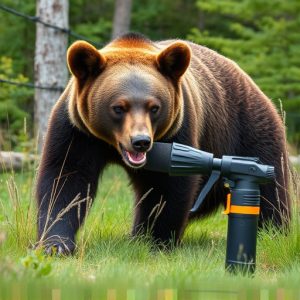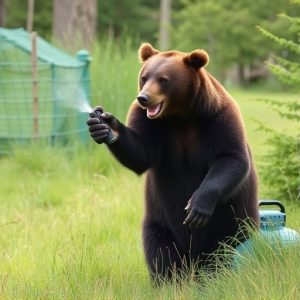Wilderness Safety: Defending Against Grizzly Bears with Bear Spray and Beyond
Grizzly bears inhabit wilderness areas across North America, demanding understanding of their behavi…….
Grizzly bears inhabit wilderness areas across North America, demanding understanding of their behavior from outdoor enthusiasts. Bear spray is an effective deterrent but comes with legal age restrictions (typically 18+), which hikers and campers must check before purchasing. Beyond meeting these requirements, preventing bear attacks involves navigating the "danger zone" (100 yards), making noise, carrying deterrents, understanding bear tracks, seasonal behavior, and receiving proper training.
In the vast wilderness, encountering a charging grizzly bear is a terrifying prospect. Understanding bear behavior and arming yourself with the right tools are crucial for survival. This article delves into the intricate world of grizzly bears, exploring their charging patterns and the effectiveness of bear spray as a defense mechanism. We’ll also discuss age restrictions for purchasing bear spray, emphasizing the importance of preparedness strategies beyond just spray for ultimate wilderness safety.
- Understanding Grizzly Bear Behavior and Their Charging Patterns
- The Role of Bear Spray: Effectiveness and Legal Age Restrictions
- Preparedness Strategies: Beyond Bear Spray for Wilderness Safety
Understanding Grizzly Bear Behavior and Their Charging Patterns
Grizzly bears, or Ursus arctos horribilis, are powerful and unpredictable animals that inhabit many wilderness areas across North America. Understanding their behavior, especially when it comes to charging patterns, is crucial for anyone venturing into these regions. These bears have an excellent sense of smell and hearing, which they use to locate potential prey or threats. They are primarily active during the spring and summer months, when they are seeking food to prepare for hibernation. During this time, encountering a grizzly bear while hiking or camping is not uncommon.
When a grizzly bears feels threatened or surprised, it may charge as a defensive mechanism. However, their charging patterns differ from other bear species. They tend to be less aggressive than black bears and will usually only charge when they perceive a direct threat. It’s important for outdoor enthusiasts to know the legal age requirements for purchasing bear spray, an effective deterrent, as it can help reduce the risk of an attack. Understanding these behaviors allows hikers and campers to take preventive measures, ensuring a safer experience in grizzly bear country.
The Role of Bear Spray: Effectiveness and Legal Age Restrictions
Bear spray is a popular and effective self-defense tool against grizzly bears in the wilderness. Its chemical composition creates a barrier, temporarily blinding and disorienting the bear, allowing you to escape or defend yourself. However, it’s crucial to understand that bear spray is not a guaranteed solution; its effectiveness depends on factors like distance, wind direction, and proper usage.
In many regions, there are strict legal age restrictions for purchasing and carrying bear spray. These regulations vary by location but typically require individuals to be 18 or older due to the potent nature of the product. It’s essential to check local laws before acquiring bear spray to ensure compliance and promote responsible wilderness safety practices.
Preparedness Strategies: Beyond Bear Spray for Wilderness Safety
In addition to carrying bear spray, understanding how to navigate encounters with grizzly bears is crucial for anyone venturing into wilderness areas where they are present. While bear spray remains a vital tool, effective preparedness goes beyond just its legal age requirements – which vary by region but often range from 18-21 years old – and includes developing an awareness of bear behavior. Knowing when and how to retreat, making noise to signal your presence, and carrying items like bells or whistles can all deter an attack before it begins.
Understanding the “danger zone” around a bear, which is typically about 100 yards, and maintaining distance within that space, are key strategies. Learning to read bear tracks and signs, as well as being aware of seasonal variations in bear behavior, can provide valuable insights into their movements and potential locations. By combining these proactive measures with proper training, individuals can significantly enhance their safety when facing a charging grizzly bear, ensuring they have the knowledge beyond just acquiring legal age-compliant bear spray.
In safeguarding ourselves in wilderness encounters with grizzly bears, understanding their behavior and employing a multi-faceted approach are key. While bear spray remains an effective deterrent, it’s crucial to know its limitations and the legal age restrictions for purchase, as per local regulations. Beyond this, staying prepared involves a combination of awareness, noise management, and having the right gear. By combining these strategies, we can enhance our safety in grizzly country, ensuring a more enjoyable and secure outdoor experience.


